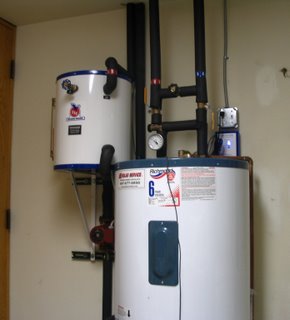Replaced Bulb Dilemma
OK, now that I've replaced 100 regular lightbulbs with CFLs, what do I do with the still working normal bulbs?
I feel bad throwing them out, because they still work. But I also feel that giving them away (i.e. to charity) is not a favor, since they actually cost more to use than CFLs. Has anyone else faced this dilemma? Any ideas?
Snaps of solar thermal system
As promised several
posts ago, here are some pictures of our new solar thermal system in action. Each panel on the roof is ~25 sq. ft. for a total of ~75 sq. ft. of collector area. The steep angle is intended to maximize sunlight intercepted in winter. Panels face south.


There are two tanks in the utility room, the small one is the thermal fluid drain back tank and the larger tank (only top half shown) is where our water is heated by the sun! (technically by the thermal fluid that was heated by the sun). We are now taking showers free of G.W. guilt.
Neat cartoon.
Gmoke has a cute
energy cartoon over at his site.
A Watt saved is $1 earned.
As we work to increase efficiency (and decrease unnecessary energy consumption) it may be interesting to look at the value of saving a watt.
Thinking about this from a product design/engineering perspective (although it applies equally to comparing products at the point of purchase) where the designer is trading off a dozen cost/benefits (including simply completing the design) what is the value of creating a product that uses 1 Watt (or 100W, etc.) less power?
Let us assume that energy costs $0.10 kWh. If the product is used 2,000 hours a year (a.k.a. the standard 40 hour work week) and will be used for 5 yrs on average, then
1W x 2,000 x 5 = 10,000 Wh = 10 kWh
So the life cycle cost of 1 Watt is $1.
If the item is designed to sell in million unit volumes, the cost of that Watt can really add up!
As in so many cases, if we look carefully we find that not all watts are created equal...
Some items are used far more (or less) often than 2,000 hrs/yr x 5 years.
A stairwell light (anything really) which is on 24/7, has a $4.40 cost per Watt (every 5 years).
Meanwhile an appliance used half an hour a day has a $0.10 per Watt cost.
As I pointed out in one of my
first posts, energy prices can also vary greatly. If you are using disposable AA batteries to power your device, you are paying ~$2 a Watt per HOUR.
Solar water distiller
I posted an entry a couple months ago about the
global water crisis.
Over the last few years I have been inventing/developing a portable solar water distiller. The idea is to create a low cost product that allows a small family to purify drinking water each day. While progress has been slow, I am making progress. The device produced 3.25 liters (0.85 gallons) in a day last summer in northern IL, a big increase over the prior year's production of 1.25 liters. I'm now roughly 40% of the way to my goal of 2 gallons/day which should serve a small family's drinking needs. I believe 2 gallons/day represents a viable threshold for a marketable product.
Distillation is a great way to purify drinking water, since it cleans up nearly any water pollutant, from removing salt from seawater to removing biologicals from surface water.
Would Americans car-pool for $1/mile?
One well known way to conserve gas is to car-pool. The obvious time to car-pool is to and from work. Unfortunately most people don't. I'm sure there are a million different reasons why, but I'll bet that at the center of everyone of these is a kernel of selfishness--I want to come and go as I please. I understand and I'm partially sympathetic to this standpoint. Nevertheless, this form of selfishness should be easily overcome with the proper incentive.
I propose a $1/mile car-pool incentive. Assuming an average daily commute is 25 miles (12.5 miles each way), this would cost $125/car-pooler/week a.k.a. $6,250 per car-pooler/year. The commuters with the longest distance to drive would have the greatest incentive to car-pool (thereby saving the most gas) so the actual per car-pooler cost might be skewed a bit higher. Split that 50-50 between driver and passenger and each gets an extra $3k/yr (not counting the money saved from not driving & parking etc).
How many people would go for this? 5%? 10%? 20%?
The best way to find out is to try it. The idea can be implemented on almost any scale (from mom and pop to multinational business; from local township to statewide policy). If 10% signed up, this incentive would cost $300 per employee.
Although it is rare, my city has good public transportation options, so I would try to offer equivalent incentives to workers to take public transportation (by for example offering several free monthly passes/yr to workers not in the car-pool program).
If your company/city has already tried something similar, tell me how it worked. Please feel free to throw this idea into the next public/private suggestion box you see.
Edit 7/17: One could start with a smaller incentive ($0.25/mile) to work out any kinks.
Effect of installing 100 CFLs
Just before installing our solar thermal system, I replaced 100+ normal lightbulbs with CFLs (more efficient lights). And no, the main house does not use 100 lightbulbs...we have 7 houses on the premises: 1 main and 6 smaller. The main house uses about 50 with ~10 per small house.
Each CFL uses ~50W less than the original bulb, so that adds up to 5 kW less consumption capacity. Not all lights are on at the same time (despite the best efforts of my 20+ nieces and nephews), so even if a maximum of 30 are used at once, that is a reduction of 1.5kW (50W x 30 bulbs) for each hour they are on. If those 30 bulbs are on 3 hours a day x 365 days/yr (~1100 hours/yr), we will save 1,650 kWh of energy use in a year.
At our ridiculous low $0.065/kWh rate, that adds up to a whopping $107 :-(
Looked at another way, a 1kW solar pv system costing ~$10k (minus incentives) would produce 1,650 kWh in a year (365 x 4.5 hrs of sun). I feel much better about my $200-$250 investment in CFLs now. :-)
[Our seven houses combined used 100,000+kWh last year. Sigh! More conservation to do.]
Solar Thermal update
Our solar thermal system is installed and operating. Woot Woot! Now we will start examining our utility bills to see if we notice the savings. We should.
At our latitude we can expect our solar collectors to collect ~1300 BTUs/sqft a day on average according to
Revelle. (I've just had time to skim Revelle's website but it looks info packed!) I'm told our panels are mounted at 52 degrees (not 45 as assumed by Revelle) although to be honest they looked closer to 60 degrees to me. This orientation means the panels will collect more energy in winter and less in summer, but will the average be higher, lower or unchanged?? (I plan to take my camera and get some shots next time I'm there.)
The installer suggested the collectors would collect 1000 BTU/sqft a day, so I'll use that for now. With three panels, we have ~70 sqft of collector area. Finally 1 kWh = 3,412 BTU (since I have no intuition as to what a BTU looks like.)
1000 BTU/sqft * 70 sqft * 1kWh/3412BTU = 20.5 kWh/day
20.5 kWh/day * 30 day/month * $0.065 kWh = $40/month
I think we will notice $40/month savings :)
Although if our electric rate remains at $0.065 kWh (unlikely but...) it will take 175 months (14.5 years) of $40/mth for a simple payback on our system (~$7,000). ~10 years if we could take advantage of $2k fed tax credit (which doesn't help AMT tax payers).
Sigh! this seems to be a long payback for a solar thermal system...it would drop to ~11 yrs if Revelle is right about 1300 BTU/sqft. And who on this globe (except us) only pays $0.065 kWh electric rates?
Is Israel Nucking Futs?
It is possible that this latest double incursion (into Gaza and Lebanon) will de-escalate as quickly as it blew up, but to my mind Israel is taking a long jump off the plateau of sanity. It seems clear to me that Israel has decided to retake control of Gaza. Obviously they have the military might (fully backed up as they are by the US government [and the US wonders that people dislike 'em]), but do they have the right?
Methinks Israel is doing even more damage to their (and the USs by association) international reputation.
More efficient tires?
I was surfing the TerraPass blog (they sell carbon credits), when I ran across
Tip # 2 for saving energy. Basically, the tip is to properly inflate your tires to maximize driving efficiency and safety. They peg the savings at ~$50/yr.
It is a great tip, but it begs the question, what is the proper inflation for your tires? If tires normally last about 4 years, then you could save $200/yr over the life of your tires (more if you keep your tires longer). This is not even quantifying the extra value from the added safety.
How hard would it be to engineer a gizmo/sensor that could measure the tire's internal air pressure and inflate/deflate the tire to optimize performance in whatever driving conditions one is in? (Yes, comment #8 was me :)
I'm guessing that such a device could be made & deployed for a few bucks a tire. Assuming a 100-300% margin for the tire company, a premium of $12-$15 per tire would allow a 1 yr simple payback (on fuel economy alone) for a customer buying 4 self-inflating/optimizing tires.
$8-$10 extra revenue per tire would have to be worth a bundle to the tire companies right?
Any tire engineers wanna collaborate with me?
Taking the solar plunge
Next week, if all goes well, my parents will be installing a solar thermal system on our country house. We will install just over 75 sq feet of solar collector area on our roof and get an 80 gallon water tank with a heat exchanger.
The installed system is estimated to cost $10k before incentives and is provided by
Solar Service Inc, a local installer operating for over 25 years, which says something considering they are based in Chicago, IL. We should get a $3k rebate from the state (my parents don't expect to get a $2k federal tax credit since they usually pay the AMT). While solar is still expensive, solar thermal systems are supposed to have the best paybacks. We will be offsetting water that is otherwise heated by electricity (which everyone knows is not very efficient) so that will be useful. We pay a low per kwh rate (6.5 cents) at the house, so I'm afraid the financial payback will be far in the future.
I'd guess we might save $500 a year, although that figure may be ambitious. I hope we get some meter with the system that can help us determine how much energy we are offsetting/saving.
Oh this reminds me, can anyone recommend a low flow showerhead that doesn't feel like its low flow?
The house is nearly 20 years old and I don't believe we have low flow shower heads (there are 4 showers) in the house and low flow would obviously help reduce hot water demand. I'm guessing the showers are currently 4, or 5 gpm. I really really like long hot showers so I don't want to buy a low flow, if its going to feel like I'm misting rather than showering.



